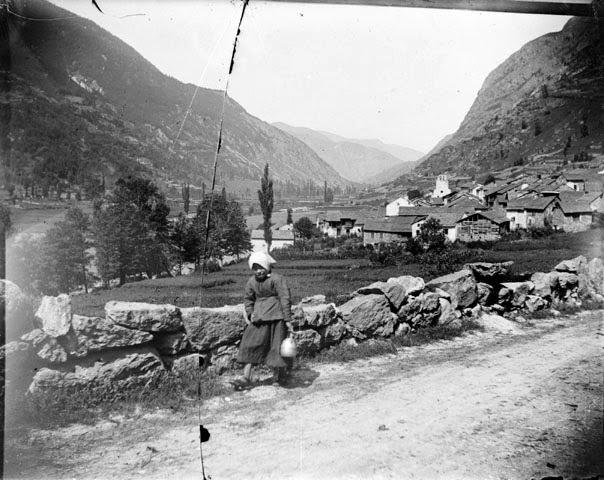Another look at the ways a photograph's deterioration can have a striking effect on its image. From the 1850s to about the 1920s, the majority of photographic negatives were made on glass, coated with a collodion or gelatin emulsion. Though glass negatives capture a lot of detail, they are also bulky, heavy... and breakable. Broken glass plate negatives are not uncommon, particularly in the collections of archives where image content is considered especially important. Digitization has been a terrific boon for these broken plates, allowing the images to be put back together and viewed in a way that often is no longer possible another way. The creation of a digital positive is sometimes especially interesting in these cases, as the missing parts of the negative end up rendered black, creating an interesting visual. The cracks themselves can have a striking effect on the image, breaking the illusion of the photograph as an unmodified glimpse of reality.
 |
| Bibliothèque de Toulouse |
Porte d'Aude, Carcassonne, France, about 1859-1910. Source
 |
| US National Archives |
Men gambling, Montana, US, 1909. Source
 |
| Costică Acsinte Archive |
People with horses, no date. Source
 |
| Bibliothèque de Toulouse |
A valley view, France, 1859-1910. Source
 |
| Bibliothèque de Toulouse |
Stereoview of a train station in Carcassonne, 1859-1910. Source
 |
| Powerhouse Museum |
Tobogganing ca. 1900, Australia. Source
 |
| Powerhouse Museum |
Climbers in Australia, ca. 1900. Source
 |
| Bibliothèque de Toulouse |
A girl on a road in the mountains, France, 1859-1910. Source
 |
| Bibliothèque de Toulouse |
A German coast, ca. 1905. Source
 |
| Powerhouse Museum |
A ladies' toboggan race, ca. 1900. Australia. Source
 |
| Bibliothèque de Toulouse |
A village in the hills, France, 1859-1910. Source
 |
| Bibliothèque de Toulouse |
Bagnères-de-Luchon, France, 1895. Source
 |
| US National Archives |
A general and his staff during the American Civil War, ca. 1863. Source
 |
| Fylkesarkivet i Sogn og Fjordane |
A choir competition in Oppstryn, Norway, ca. 1900-1922. Source

No comments:
Post a Comment